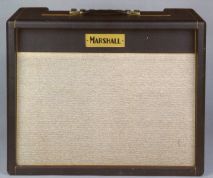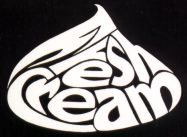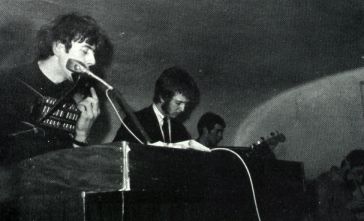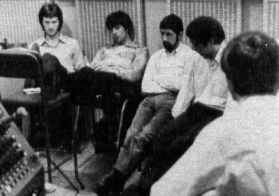
1962 (Series 1) 45W 2x12 Combo
This was generally considered to be EC's first Marshall model but photos
show he used a JTM45 head & quad box

The above is the simple version that legends require. The reality is somewhat different.
|
When Eric Left the Yardbirds and joined John Mayall in April 1965, he also adopted a new set-up to enhance the change. He moved from the Telecaster/Vox to a Les Paul (58-60)/Marshall JT45 head and flat quad (4x12) box . In June 1965, the Bluebreakers entered the studio to record a single (‘I’m Your Witch Doctor’/’Telephone Blues’ + ‘On Top of the World’). The producer was Jimmy Page who was gob smacked by the sound Eric was getting with the Les Paul combined with the over-driven Marshall. The engineer demanded that it be turned down as it was noise not a guitar but Page, to his everlasting credit, told him to record it. They did it with distance miking as the mike overloaded with the volume. |
| When Eric returned from his ill fated ‘world tour’ in November 1965, he had his prized Les Paul but no Marshall JT45. He went to Jim Marshall’s shop in Hanwell and bought one of the very new Release 2, 50 Watt combos. In November or December 1965, Eric and John Mayall entered the studios and recorded ‘Lonely Years’ and ‘Bernard Jenkins’. Once again Eric was at high volume but the Producer, Mike Vernon acquiesced – they were only a duo so they could manage his volume. He also played on some sessions for Champion Jack Dupree and Otis Spann but at noticeably reduced volume. |
|
Eric had joined Mayall for his more purest approach to the blues. He had left in August due to increasing ennui. The November Bluesbreakers contained a new bass player – Jack Bruce. They hit it off immediately and Eric was musically stimulated as never before. Some of that rapport is in evidence on the "Live at the Flamingo" recorded in November 1965. In December Jack joined Manfred Mann simply for the money as he had a wife to support.
Over the next few months of intense touring Eric’s integration of his sound developed. The new combo was theoretically only marginally more powerful but with slightly different electronics that gave it greater attack. When turned up to maximum (at a guess probably only 9 but with what tone control settings – presence full, treble high?), in conjunction with the Les Paul, the sound was absolutely original. Eric’s legend began to develop with the "God" graffiti appearing on walls. One should be cynical about this – management often-payed people to do this sort of thing!

While touring Eric would occasionally run into Ginger Baker. Ginger was becoming increasingly disenchanted with Graham Bond and his mind was turning to organising his own band. As Eric became more bored with the Bluesbreakers, he too began to think of his own band and sounded out some people including Stevie Winwood. No one took the young, moody Eric seriously – at this time he was no band leader.
 |
In early April Ginger Baker deliberately travelled to Oxford to sit in with the
Bluesbreakers. Eric was so bored he was, according to different witnesses, playing either
lying or sitting down! He immediately invited Ginger to sit in – they clicked.
Afterwards, over a pint, Ginger invited him to join his band. Eric agreed but with one
stipulation – Ginger’s old sparring partner had to be the bassist. Ginger
swallowed his pride and invited Jack on board. Soon after Eric, Jack and Ginger were invited to do some recording in a ‘supergroup’ session called "The Powerhouse". Jack was so shocked that he let the cat out of the bag to Paul Jones, the session organiser, who he swore to secrecy. Ginger never turned up and Eric put in a disinterested, lack lustre, but still interesting, performance even on "Crossroads".
|
Later in April, Mayall was booked in by Decca to record an album. The producer was again Mike Vernon but with a new engineer, Gus Dudgeon. Gus couldn’t balance the sound as Eric was playing at full live volume and he couldn’t get Eric to relent. When Vernon arrived he too tried to convince Eric to turn it down as this time it was with a full band. Eric refused outright against everyone’s pressure – he had nothing to lose as this would be the last recording with Mayall. John told Vernon to let it go and record as best he could. It was planned as a quick ‘live’ session so they recorded. On playback both Vernon and Dudgeon realised that they had captured a new sound even though it was technically incorrect.



Without doubt one of the classic Blues albums was recorded and one of the greatest white Blues albums. With the opening notes of Otis Rush’s "All Your Love", the Clapton Les Paul/Marshall sound is displayed in all its glory. Eric plays with incredible confidence and surety – his years of practice and learning from the great, black blues guitar masters, had now fully payed off. One can only speculate that his jamming with two other master musicians had also enhanced his confidence.
 |
The album has its weak points specifically Mayall’s show pieces and the superfluous horns. One critic’s complaint that Eric’s volume "left McVie and Flint barely audible" is arrant nonsense. McVie solidly underpins the session while Hughie Flint provides very effective accompaniment on the drums. The sound balance, in fact, set the style for quite a few years – guitar dominance. |
| On release in August, "John Mayall & the Bluesbreakers with Eric
Clapton" raced up the charts. It also turned ears in the USA when released there,
including Jimmy James. It was one of the key albums in the summer of 1966 that began to
define a new music genre called Rock. However, Clapton was now recording with his new band
called Cream.
|
 |
Footnote: In actuality Eric was not the first to record with overloaded amps. Many black bluesman had done it . Also other guitarists, such as Dick Dale, used the technique to achieve their sound. However that was more a side effect of playing at volume with small amps. The unique aspect of Eric’s sound was the Les Paul coupled with the particular sonic output of the over driven Marshall combo and his deliberate and calculated use of the overload. Mike Vernon must be congratulated for mixing the album so that the guitar actually retained its loudness and presence. That’s what really set it apart.
© Graeme Pattingale, 1998
With thanks to Delta Nick